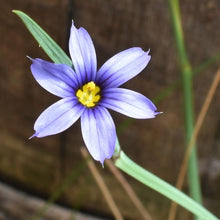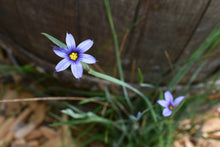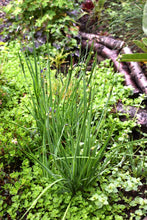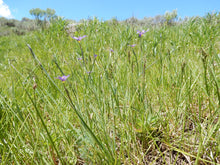
Sisyrinchium idahoense
Blue-eyed grass is not actually a grass, but a sweet little native iris (dang those confusing common names!) sporting flat, grass-like leaves and deep blue to violet flowers with cheerful yellow centers. By early summer, flowers transition to dry dark or pale-brown capsulated fruits with one to several seeds inside. Its small tufts of semi-evergreen foliage are a lovely and nearly-year-round addition to wet meadows, raingardens and other sunny, moist areas.
- Plant type/canopy layer: deciduous, perennial, herbaceous plant
- Size at maturity: 8-12" tall, 6-12" wide
- Light requirements: full sun to part shade
- Moisture requirements: moist to wet soil
- Bloom time: April - August (May - July in the Portland Metro area)
- Growth rate/ease: medium growth rate, easy to grow
- Wildlife support: flowers attract and provide nectar for hummingbirds, adult butterflies, bees and other insect pollinators; overall plant attracts and supports beneficial and pest eating insects
- Native habitat/range: common in wet areas and marshes from British Columbia to California and east to Montana and New Mexico. Portland Plant List - yes.
- Special features & uses: landscape uses include rock gardens, wet meadows and rain gardens
Gardening with Blue-Eyed Grass: This showy perennial prefers full to partial sun with soils that are moist or seasonally wet soils. That said - it can survive going bone dry periodically in the summer months and does not need supplemental water once established in the right places. It makes a lovely border along the edge of a moist wildflower meadow or raingarden. It will spread gently by rhizomes and seeds that eventually grow new plants over time, with each new babe being a welcomed and exciting addition to the garden. As clumps become larger, they can also be divided and moved around. Always separate clumps in fall or early spring, outside of the main growing season, when soils are moist and temps cooler.
Photo Credits 1-3: Nikkie West, Sparrowhawk Native Plants
Photo Credit 4: "Sisyrinchium idahoense" by Matt Lavin is licensed under CC BY-SA 2.0







